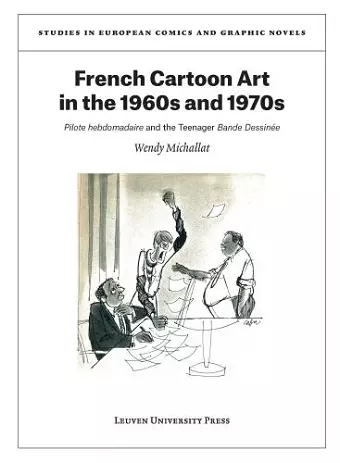French Cartoon Art in the 1960s and 1970s
Pilote hebdomadaire and the Teenager Bande Dessinee
Format:Paperback
Publisher:Leuven University Press
Published:25th Jul '18
Currently unavailable, our supplier has not provided us a restock date

The French comic magazine Pilote hebdomadaire arrived in a weakening comics market in 1959 largely dominated by syndicated translations of American comics and comics inspired by a Catholic ethos. It tailored its content and tone to an older adolescent reader far removed from that of France's infant comic. Pilote's profile set it on a turbulent course subject to the vicissitudes and fickleness of fashion which situated it within an emerging teenager press under pressure to renew and innovate to survive. When it made cartoons its defining characteristic in 1963, Pilote articulated its uniqueness by channelling teenager discourse through them whilst also trying to encourage a zest for education in a modernising and economically buoyant France of exciting new opportunities. Pilote's cartoon art thus became a dynamic repository for the ideas and attitudes of France's educated youth which evolved into the radical discourses of the lifestyle and political revolutions of the late 1960s and early 1970s.This book tells how Pilote hebdomadaire's unique positioning in a new and fast developing youth press market for teenagers provided the forum and catalyst for the bande dessinee's stylistic evolution over the course of the 1960s and 1970s.
Cette étude est toutefois aussi intéressante que les cinq précédentes. Elle éclaire des thèmes peu abordés dans d’autres livres sur Pilote (dont les quatre textes cités, publiés avant 1999) et sur les magazines et la BD des années 1960, mais ici montrés à travers une méthodologie claire appuyée sur des exemples visuels bien choisis.
C[h]ris Reyns, Belphégor [Online], 18, 1 | 2020, Online since 14 January 2020, http://journals.openedition.org/belphegor/2136
The book is part of Leuven University Press’s Studies in European Comics and Graphic Novels, an impressive series that offers important contributions to this growing field of study. [...] Her scholarship embodies the best of academic writing in that it satisfies the specialist’s need for documentation and deep analysis, while remaining accessible for students and non-specialist readers.Stephanie Schechner, Studies in 20th & 21st Century Literature: Vol. 43: Iss. 2, Article 20. https://doi.org/10.4148/2334-4415.2084
On ne peut que recommander ce livre bien documenté et bien écrit à tous ceux qui s’intéressent à l’histoire des BD en France.Edward Ousselin, The French Review, Volume 93, No. 1, October 2019
Despite growing academic interest in bandes dessinées, relatively little has been written about the magazines which publish them. Consequently, Wendy Michallat’s study of the youth weekly Pilote is most welcome: it sheds valuable light not only on bandes dessinées development, but also on the evolution of the French press and on broader trends in society. Ample context is given by the huge range of documents consulted: government policy papers; comments by educators and journalists; letters from readers; interviews with artists, editors, and parents. References to other youth publications, some almost forgotten today, as well as to English-language outlets, provide useful points of comparison.
Matthew Screech, French Studies, Volume 73, Issue 3, July 2019, https://doi.org/10.1093/fs/knz104
'Although there exist quite some studies on the journal, the study by Wendy Michallat is the very first one to rethink its history in a broader perspective, not just that of comics culture, but that of culture at large. And the result is absolutely breath-taking. First of all because Michallat gives a very detailed yet nuanced and well written overview of the various periods of the magazine, whose history is one of nearly permanent crisis and eternal attempts to relaunch new formats and formulas in a publication niche that was much less profitable than it was often thought. Second, and most importantly, because the author succeeds in doing what other studies fail to do, namely explaining the systematic changes in the magazine’s policy.'Jan Baetens, Cultural
Studies Leuven, 3 August 2018
ISBN: 9789462701229
Dimensions: 230mm x 170mm x 15mm
Weight: 645g
268 pages